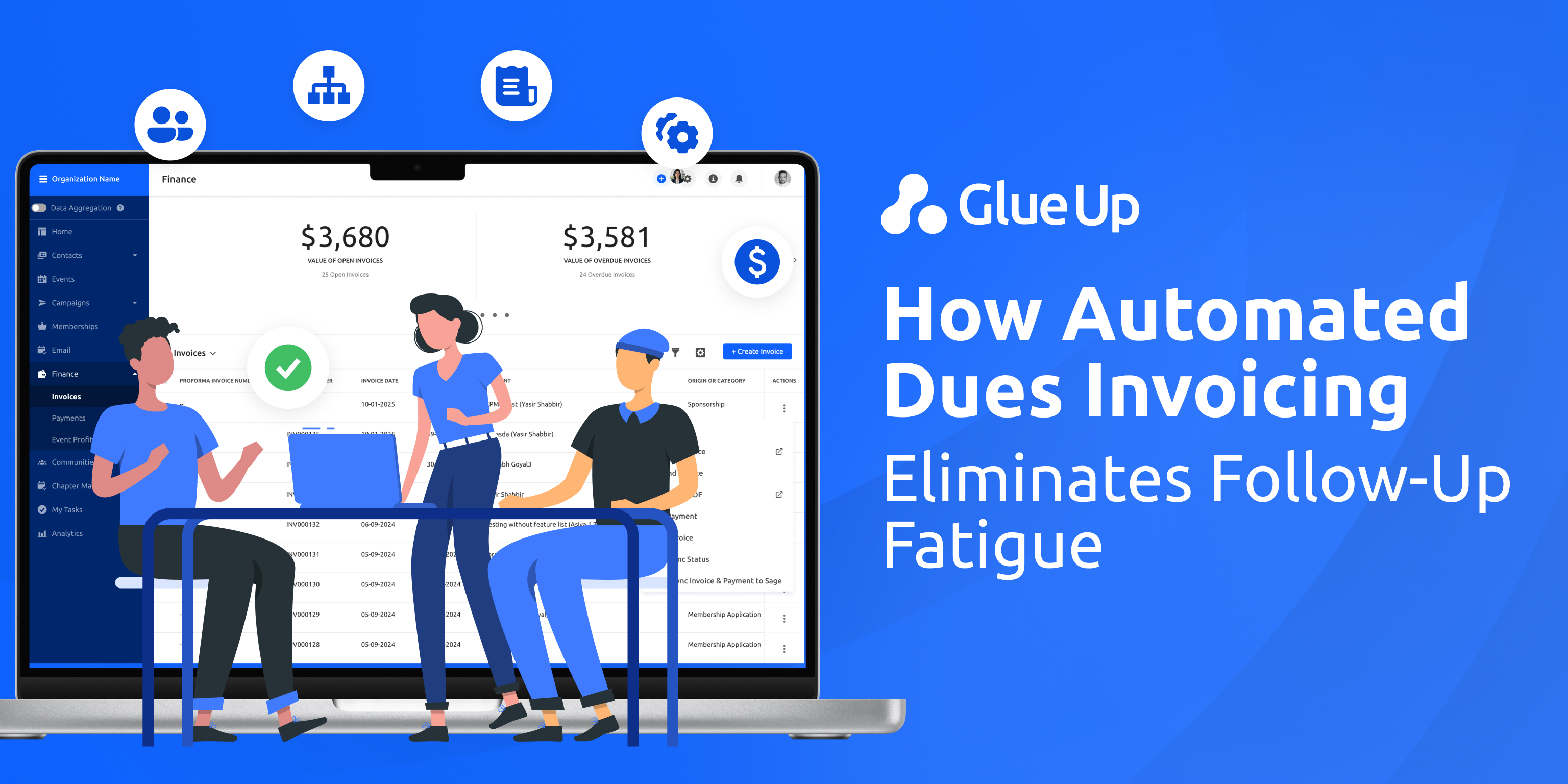
Every membership office knows the grind of renewal season: overdue invoices pile up, staff send reminder after reminder, and the phone calls no one wants to make finally begin. This cycle of chasing payments is what many call follow-up fatigue, a drain on time, energy, and credibility. The smarter alternative is to send automated dues notices, as a deliberate strategy to protect finances and strengthen retention.
When associations shift from manual reminders to automated invoicing, the payoff is more than faster payments. Teams recover hours once wasted on collections, morale improves, and cash flow steadies. Research on accounts receivable automation shows that automation can cut collection times by as much as 67% (PYMNTS Intelligence). That kind of improvement is the difference between burnout and bandwidth, between slipping renewals and sustainable growth.
Key Takeaways
-
Sending automated dues notices eliminates follow-up fatigue. Instead of staff spending hours chasing invoices, automation standardizes cadence, reduces emotional labor, and preserves professionalism.
-
A structured 4-step reminder cadence drives results. Early (T-30), urgent (T-7), deadline (Due-Day), and overdue (+7) reminders can increase on-time payments by 25–40%, outperforming one-off reminders.
-
Escalation rules protect both members and staff. Late fees (+14 days) suspended noncritical benefits (+30 days), and final demand notices (+45–60 days) create clear thresholds that build trust and compliance.
-
Automation improves cash flow and retention. Metrics like Days Sales Outstanding (DSO), on-time payment rate, and touches per invoice prove the impact, automation can cut collection time by up to 67%.
-
Implementation can be done in just 14 days. With tools like Glue Up, Stripe, and QuickBooks, associations can launch automated notices within two weeks by focusing on governance, payments, templates, and dashboards.
-
Compliance and transparency are non-negotiable. All late fees must be disclosed in agreements and align with state law. Transparent policies build trust even in escalation.
-
Glue Up makes automation member-first. By integrating renewals, payments, and accounting in one platform, Glue Up helps associations deliver a modern, frictionless experience that strengthens retention.
Quick Reads
Why Sending Automated Dues Notices Changes Renewal Math
Renewals are about psychology. Every overdue email a staff member writes carries friction. Members feel nudged, staff feel drained, and the entire process becomes reactive instead of structured. When you send automated dues notices:
-
The cadence is predictable. Reminders feel like standard practice.
-
Smart payment retries recover failed cards silently, without awkward calls.
-
Clear, concise subject lines and one-click payment links raise response rates.
-
On-time payments rise while days sales outstanding (DSO) fall.
It’s aligning invoices with professional norms members already expect from modern subscription businesses: Netflix, Spotify, Amazon Prime. Your association is competing with those standards.
The 4-Step Cadence to Send Automated Dues Notices
Automation only delivers results if it mirrors how people actually process information. Members don’t want to be bombarded with constant nudges, but they also can’t act on a single reminder lost in an inbox. That balance is why associations that send automated dues notices using a structured, four-step cadence consistently outperform those that rely on ad hoc outreach.
Research from subscription platforms and association management systems shows that multi-touch renewal sequences can increase on-time payments by 25–40% compared to one-off reminders. Behavioral studies on payment psychology point to the same conclusion: people are more likely to act when reminders arrive in a rhythm that aligns with natural decision points; well in advance, shortly before, on the deadline itself, and with a final post-deadline nudge.
Here’s what that cadence looks like in practice:
T-30 Days (Heads-Up Notice)
-
Subject: “Your membership renews on [date], quick heads-up.”
-
Purpose: Establish awareness early, before billing becomes urgent. This notice works best when it reinforces benefits: event access, discounts, or directory listings members don’t want to lose.
-
Best practice: Keep it under 100 words, frontload the value of staying current, and provide a one-click renewal link. Early reminders have been shown to reduce overdue invoices by as much as 15% in SaaS and subscription models.
T-7 Days (Reminder)
-
Subject: “7 days left to renew your [org] membership.”
-
Purpose: Create urgency without hostility. A week before expiry, members are more receptive to reminders framed as protection of their benefits rather than a debt notice.
-
Best practice: Pair urgency with empathy. Acknowledge busy schedules and highlight multiple payment methods (ACH, card, direct debit). Case studies from Neon One suggest this is the highest-converting reminder stage in association renewals.
Due-Day (Action-First)
-
Subject: “Renew today to keep access active.”
-
Purpose: Anchor behavior on the deadline itself. Most members act at the last possible moment, and an action-first subject line ensures they know exactly what’s at stake.
-
Best practice: Place the renewal button in the first line of the email. Payment studies confirm that emails with the primary link above the fold see up to a 70% higher click-to-payment rate. Offer frictionless options: credit card, ACH, PayPal, or mobile wallet if supported.
+7 Days (Overdue)
-
Subject: “Past due, renew now to avoid fees.”
-
Purpose: Enforce accountability while still preserving the relationship. At this stage, the member has missed the deadline, so tone matters: firm but not punitive.
-
Best practice: Reference the late fee or suspension policy clearly, since transparency builds trust even when delivering bad news. Include a direct support line for members facing genuine payment barriers. According to renewal data from WildApricot, overdue notices sent within a week of the lapse recover as much as 40% of delinquent accounts.
This rhythm transforms invoicing from a reactive scramble into a predictable member experience. It eliminates the guesswork of “when to follow up,” while aligning with proven behavioral economics. Instead of staff improvising tone and timing, the cadence standardizes both, reducing emotional labor for staff and normalizing the payment process for members.
The lesson is clear: when associations send automated dues notices with discipline and consistency, invoices stop feeling like awkward reminders and start functioning like part of the membership experience itself.
Escalation Rules That Respect Members
Automation is setting clear, predictable thresholds that protect both the organization and its members. When you escalate overdue dues in a structured way, you reduce guesswork for staff, avoid arbitrary decisions, and give members multiple opportunities to correct course without feeling ambushed.
+14 Days: The First Escalation Point
Two weeks past due is the point where reminders shift from routine to escalated. If your bylaws or membership agreement allow it, this is the stage to apply an automated late fee. The amount must be disclosed upfront and legally permissible. Alongside the system-generated fee, staff should receive a task to personally call or email high-value members; longstanding members, sponsors, or those with leadership roles. The human touch matters here: automation enforces policy, while staff outreach preserves relationships.
Why this works: Late fees alone are not enough to change behavior; coupling them with a personal check-in shows accountability and empathy. Research on collections in membership-based organizations shows that combining automated penalties with human outreach increases recovery rates by more than 20%.
+30 Days: Temporary Suspension of Noncritical Benefits
At the 30-day mark, automation should do more than send emails. Associations can suspend noncritical benefits such as discounted event tickets, premium resources, or directory listings. Essential communications, however, must remain open, members still need access to notices, board updates, and renewal instructions.
Why this works: Psychologists call this “loss aversion”, people act faster to avoid losing access than to gain a discount. Associations that tie tangible benefits to active dues status report sharper spikes in recovery at this stage compared to repeated email-only nudges.
+45–60 Days: Final Demand with Flexible Options
When overdue accounts reach 45–60 days, the tone must be direct yet professional. This is the final demand notice, but it’s also the last chance to offer flexible payment options. Associations that accept ACH, SEPA Direct Debit (for Europe), or updated card credentials recover more accounts at this stage than those relying on checks or manual transfers.
Best practice: The final notice should not read like a collections agency letter. It should highlight consequences (possible suspension or termination) but pair them with support: “If you are experiencing financial hardship, contact us to discuss options.” Flexibility here preserves goodwill and often rescues members who want to stay but simply needed another method to pay.
The Legal Lens
Automation must never override the law. In the United States, the Federal Debt Collection Practices Act (FDCPA) makes it clear: you cannot impose fees that aren’t authorized by the agreement or permitted by statute. That’s why disclosure is non-negotiable, late fees must be written into your membership contracts and consistently applied.
Example: Florida homeowner association law caps administrative late fees at the greater of $25 or 5% of the overdue installment. While associations outside of Florida may have different rules, the principle holds: check state law, align with bylaws, and never surprise members with unannounced penalties.
The takeaway: Fair escalation rules ensure members always know what to expect. They keep your team from improvising policies under pressure and build trust by pairing accountability with clarity. When associations embed these thresholds into their automated systems, dues collection stops being reactive and starts being predictable, for everyone involved.
Tools That Make Automated Dues Invoicing Work
The technology stack that delivers automated dues notices is less complex than it sounds.
-
Glue Up: Membership logic, renewal reminders via email and push notifications, recurring billing, self-service portal, and integrations with Stripe and QuickBooks.
-
Stripe Billing: Smart retries, dunning flows, and support for multiple payment methods.
-
QuickBooks Online: Configurable reminder schedules and rule-based late fees with grace periods.
-
WildApricot and Neon One: Built-in multi-touch renewal settings for associations.
What matters is not the tool itself, but the integration. Glue Up stands out because reminders live where your member record lives. That means finance, membership, and events all speak the same language.
Metrics That Prove Follow-Up Fatigue Is Gone
Automation has to do more than “feel” efficient, it has to prove it. The surest way to silence doubts in the boardroom is through metrics that quantify both financial gains and staff workload reductions. When you send automated dues notices, the numbers tell a story of fewer manual touches, faster payments, and healthier cash flow.
Days Sales Outstanding (DSO)
The average number of days it takes to collect dues after they’re invoiced. High DSO is a red flag for cash flow instability. According to PYMNTS, AR automation can reduce collection times by as much as 67%. For associations, even a 10-day reduction means more liquidity for programs and less scrambling to cover operational costs.
On-Time Payment Rate
The percentage of members who pay on or before the due date. This figure directly reflects whether your cadence of reminders is effective. Associations using structured, automated schedules report 25–40% higher on-time payment rates than those relying on one-off reminders.
Touches per Invoice
The number of staff interactions (emails, calls, tickets) needed to close a single payment. Every touch represents labor. Pre-automation, staff often make 3–5 attempts before a member pays. With automation, this can drop to just one system-triggered reminder. Target: cut touches in half or more, freeing staff to focus on retention and programming.
Reminder-to-Payment Conversion
Which stage of the reminder cadence actually secured payment (T-30, T-7, due-day, or overdue). Tracking conversion by step allows you to fine-tune messaging. For example, if 70% of payments close at T-7, you can emphasize benefits in that reminder. If most payments come on the due date, you may need to strengthen urgency in the earlier notices.
Recovery via Smart Retries
The percentage of failed card payments that succeed automatically after retries. Systems like Stripe use machine learning to time retries for optimal success. This silent recovery, sometimes accounting for 10–15% of recurring billing revenue, means staff never have to pick up the phone for failed payments.
Time-to-Reconcile
How long finance spends matching payments to invoices. Manual reconciliation is one of the most time-consuming finance tasks. When dues notices are automated and integrated with accounting software like QuickBooks, reconciliation time shrinks dramatically, and error rates fall.
Presenting Proof to the Board
Boards respond to evidence. A simple pre- vs. post-rollout dashboard over 90 days is enough to validate the shift. If touches per invoice fall by 60% and DSO drops by 10 days, you’re demonstrating financial discipline and operational maturity.
In the boardroom, that’s the kind of story no treasurer, finance chair, or executive director can ignore.
How to Implement Automated Dues Notices in 14 Days
The idea of automating dues often sounds like a multi-month systems overhaul, but the reality is different. With the right platform, you can send automated dues notices in under two weeks. The key is to focus on policy, payments, templates, and reporting.
Step 1: Confirm Terms (Days 1–2)
Start with governance. Review bylaws and membership agreements to confirm grace periods, late-fee authority, and escalation policies. If late fees aren’t disclosed in agreements, you can’t charge them. Get board approval to document these rules so members know what to expect. Transparency here prevents disputes later.
Step 2: Connect Payments (Days 3–5)
Set up your payment gateway: Stripe, PayPal, or equivalent; to handle cards, ACH, and (for European members) SEPA Direct Debit. Enable Smart Retries, which use network data to automatically recover failed card payments. Studies show that these retries can recover 10–15% of failed charges without staff intervention.
Step 3: Sync Accounting (Day 6–7)
Integrate with your accounting software: QuickBooks or Xero; to ensure invoices, payments, and late fees reconcile automatically. This removes the double-entry workload finance teams usually shoulder. McKinsey research on AR automation highlights that reconciliation speed is one of the top drivers of ROI.
Step 4: Load Templates (Days 8–9)
Draft email and in-app reminder templates for your four-step cadence (T-30, T-7, due-day, +7 overdue). Use tested subject lines and body copy that’s short, clear, and action-oriented. Tokenize details like invoice number, amount, and due date so members see personalized notices.
Step 5: Publish Policy (Day 10–11)
Make your rules visible. Post your renewal and late-fee policy on your website or member portal. When members know the rules in advance, they’re less likely to push back later. This is also a compliance safeguard: federal and state laws require fee transparency.
Step 6: Launch Dashboard (Day 12–14)
Stand up a dashboard to track KPIs like DSO, on-time payment rate, and reminder-to-payment conversion. Compare these against your baseline from the last quarter. Even in the first cycle, you should see a visible drop in staff touches per invoice and an improvement in payment timeliness.
Why Sending Automated Dues Notices Improves Retention
Automation feels impersonal, but it actually improves relationships. Members don’t feel singled out when everyone receives structured, professional reminders. Staff avoid the resentment that comes with chasing. Retention rises because payment becomes effortless instead of a source of friction.
Glue Up’s data shows that when renewals and reminders are automated, retention lifts significantly. That’s because members pay on time, don’t lapse into avoidable suspensions, and re-engage faster if they do fall behind.
Compliance and Member Trust
Automation must align with trust. The Federal Debt Collection Practices Act (FDCPA) principle is clear: you cannot collect what is not authorized or permitted by law. Associations must disclose late-fee policies upfront, specify grace periods, and follow state-level statutes. Transparency is not only a legal safeguard; it’s a trust builder.
The First 14 Days with Glue Up
Picture this:
-
Day 1: You publish your updated renewal and late-fee policy on your site.
-
Day 3: Stripe is connected; Smart Retries are on.
-
Day 5: QuickBooks is synced; reminder schedules are live.
-
Day 7: Templates are loaded; portal banners are active.
-
Day 14: Your first batch of automated notices goes out. Staff watch invoices clear with no manual follow-up.
It’s what happens when associations stop improvising invoicing and start structuring it.
End Follow-Up Fatigue with Automation
Follow-up fatigue is lost revenue, strained relationships, and a reputation that feels less than professional. When you send automated dues notices, you cut through the noise. You protect cash flow, reduce administrative drag, and give members the modern experience they already expect.
Associations win by working smarter. The future of dues invoicing is automated, fair, and member-first.
Book a demo with Glue Up today and see how renewal reminders, payment automation, and accounting sync can end follow-up fatigue in your association.



